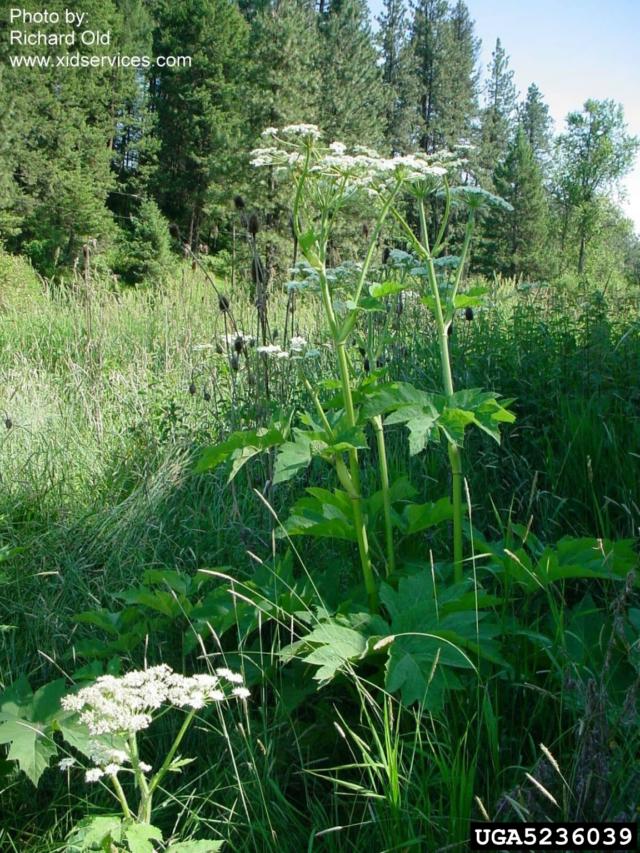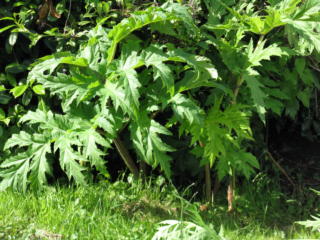Part Two: Giant Hogweed (Heracleum mantegazzianum)
Often when we talk about invasive plants you hear about the potential they have to cause significant economic or ecological damage, but what about impacts to our health? In this series we will explore three hazardous plants to be aware of to keep you, your family and friends out of harms way.
Giant Hogweed Facts
- Very tall (up to 5.5m when in flower), short-lived perennial in the Parsley family.

Giant hogweed (Heracleum mantegazzianum) - Leaf, deeply lobbed with a serrated edge, somewhat glossy, 5 feet wide
- Large white umbrella-shaped flowers
- Reproduces by seed only.
- Prefers damp, rich soil, and can grow vigorously in various light conditions including full shade. Most commonly found in ditches, wetlands, riparian areas, wooded ravines, roadsides, and other disturbed sites.

Giant hogweed leaves
Look A Likes
Every year we receive reports of giant hogweed in the area. Thanks very much folks for your reports! To date, all reports have been identified as cow parsnip (Heracleum maximum), a common native plant species.Here is some information to assist you in accurately identifying cow parsnip and giant hogweed.
| Cow Parsnip (Native) | Giant Hogweed (Invasive) | |
| Leaves | NOT shiny, broad less serrated than giant hog weed Resembles a ‘funny’ maple leaf 76 cm wide | Shiny and large with serrated ‘jig saw’ leaf edges & dappled lobbed Up to 150 cm wide |
| Stem | Flower stalk smooth with soft hairs Mature height 1m-2m | Flower stalk has stiff hairs with bristly feel & purple blotches Mature Height 2 m to 5 m |
| Flowers | Smaller flower heads, 20 cm diameter | Large umbrella shape, 150 cm in diameter |
For more info visit our blog: Giant hogweed vs cow parsnip: What is the difference?

Consequences of Invasion
- Health Risk: Sap (found in leaves, stalks, and stem hairs) contains toxins that can cause severe skin inflammation and painful burns if affected skin is exposed to sunlight. Scars can persist for many years. Worksafe BC has issued a special Toxic Plant Warning for this species.
- Seek medical attention if your skin has come in contact with giant hogweed.

Giant hogweed burn
How to control?
CALL CKISS for treatment options. 1-844-352-1160 ext 206.
- Anyone handling Giant Hogweed parts should wear waterproof gloves and outerwear, as well as safety glasses to protect skin from toxic sap. Refer to WorksafeBC’s Toxic Plant Warning for more details.

Crew removing toxic giant hogweed in the proper safety gear.





